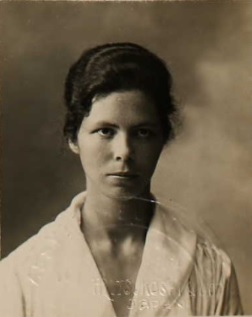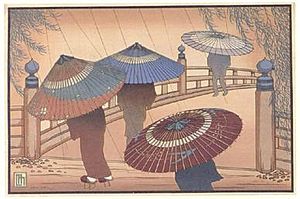Lilian May Miller facts for kids
Quick facts for kids
Lilian May Miller
|
|
|---|---|

Lilian May Miller, passport photo, 1918
|
|
| Born | 20 July 1895 |
| Died | 11 January 1943 (aged 47) |
| Nationality | American |
| Education | Kano Tomonobu (Kanō school, Tokyo), Shimada Bokusen |
| Known for | Drawing, Painting, Watercolor painting, Printmaking, Woodblock printing, Poetry |
Lilian May Miller (born July 20, 1895 – died January 11, 1943) was an American artist. She was a talented painter, woodblock printmaker, and poet. Lilian was born in Tokyo, Japan.
She became known in the art world for her unique style. She often wore traditional kimonos when showing her art. She also signed her paintings with a special symbol called a monogram. Lilian May Miller learned traditional Japanese painting styles. She created beautiful sketches, ink paintings, and woodblock prints. Her art often showed people and landscapes from Japan and Korea. These were the countries where she lived for most of her life.
Contents
Her Life Story
Growing Up and Learning
Lilian May Miller was born in Tokyo, Japan, on July 20, 1895. Her father, Ransford Miller, was an American diplomat. Her mother, Lilly Murray, taught English. Lilian had a sister named Harriet. Lilian herself was often called "Jack" by her family.
When Lilian was nine years old, she started studying art. A famous artist named Helen Hyde suggested it. Lilian joined the art studio of Kanō Tomonobu in Tokyo. He was the head of the famous Kanō school of painting. Just three years later, she showed her first artworks! She even had a special art name, Gyokka, which means "jeweled flower."
Later, her father moved back to Washington, D.C. Lilian left Japan for the first time to go to the United States. She went to Central High School in Washington, D.C. At age 14, she won an art contest with her painting Early Morning in Old Japan. She then went to Vassar College in New York. She graduated with honors in 1917.
Life as an Adult
In 1918, Lilian moved to Seoul, Korea. Her father was working there as the American Consul General. She worked as a journalist and secretary for a short time. Then, she returned to Tokyo in 1920.
In 1923, a huge earthquake hit Tokyo, called the Great Kanto earthquake. Many of Lilian's prints and paintings were destroyed. She then lived with her parents in Seoul, Korea, until 1927 or 1928. During this time, she made more prints. She also recovered from a serious illness. In 1930, Lilian returned to Japan and moved to Kyoto.
In 1936, Lilian and her mother moved to Honolulu, Hawaii. This happened after some political problems in Japan. In 1938, she moved to San Francisco. Here, she started to include the giant redwoods and cedars of California in her art. She loved to hike in California's San Gabriel Mountains and explore Alaska.
Lilian had a very interesting personality. She often wore kimonos when showing her art. This showed her Japanese upbringing. But she also sometimes wore men's clothes and called herself "Jack." She was American, but she lived most of her life in Asia.
After the Japanese attack on Pearl Harbor in 1941, Lilian felt betrayed by Japan. She destroyed many of her woodblock prints. During the war, she worked against the Japanese. She became a Japanese censor and research analyst for the Navy. Lilian May Miller passed away on January 11, 1943, in California. She died from abdominal cancer. Her ashes were buried in San Francisco.
Her Amazing Art
Painting Styles
After graduating from Vassar, Lilian returned to Japan. From 1917 to 1918, she studied with Shimada Bokusen. In 1920, she won an award at the Japanese Imperial Salon. This was for her ink painting of Queen Min's Gyeongbok Palace pavilion. It was called In a Korean Palace Garden.
In the 1930s, Lilian started using a new style. She began making popular watercolor paintings. She made over 100 watercolor paintings. She often worked outdoors to capture nature's beauty.
Woodblock Printing
In Japan she was a foreigner trying to keep a traditional art alive. In America she was trying to share the 'beautiful spirit of Asia'.
Modern Women in China and Japan
Lilian Miller made Shin-hanga woodblock prints. These were a modern version of traditional Ukiyo-e prints. Ukiyo-e prints were popular in the 1700s. They were often called "pictures of the floating world." These prints were affordable artworks that many people could buy.
Traditionally, making woodblock prints was a team effort. The artist would create a sketch. Then, different woodblocks would be carved for each color. Finally, a printer would use these blocks to make the prints. But Lilian Miller did all the work herself! She created the images, carved the woodblocks, and made the prints. This made her very special.
In 1920, she started focusing on woodblock printing. She created images of Korean people and landscapes. She sold her prints in Tokyo and the United States. She worked with a block-carver named Matsumoto and a printer named Nishimura Kumakichi. From 1920 onwards, she earned her living as a printmaker. Her prints were sold in many cities, including Tokyo, Seoul, and major American cities. Many of her prints were even made into postcards.
After the 1923 earthquake, Lilian moved to Korea. There, she created more stylized prints. She made prints of everyday scenes. These included children playing or women hanging laundry. One famous print is A Strange Scene in Korea. It shows a woman carrying a baby on her back with a basket on her head. Another is Korean Farm House under the Moonlight.
In 1928, Lilian made a beautiful print called Rain Blossoms. It shows colorful umbrellas, which look like "blossoms." These stand out against the plain background of people. Willow trees and a bridge are traditional Asian designs in the print. This print is considered a wonderful example of her work. Other famous prints include Nikko Gateway and Festival of Lanterns. Most of her art showed scenes from Japan.
In 1929 and 1930, Lilian visited the United States for six months. She gave demonstrations on woodblock printing. She visited galleries and museums in many cities, like Boston and New York City. During her shows, she always wore an elaborate kimono. People admired her ability to do the entire woodblock printing process by herself. Her works were collected by famous museums, like the Art Institute of Chicago.
Important Supporters
Lilian had many important female supporters and collectors. These included Empress Kōjun of Japan. Also, Lou Henry Hoover, the wife of U.S. president Herbert Hoover, admired her work. Anne Morrow Lindbergh, a famous aviator, was another supporter. Grace Nicholson, a well-known art dealer in Pasadena, California, was also a key friend. Their friendship helped Lilian meet many important art contacts during her American trip.
Art Collections
Lilian Miller's work Moonlight on Mt. Fuji, Japan can be found in the Smithsonian American Art Museum.
Her Poetry
In 1927, Lilian Miller published a book of her poems. It was called Grass Blades from a Cinnamon Garden. The book also featured her own woodcut prints. Some people felt her poems were simple. But they agreed that her art was becoming more beautiful and natural.
Later Recognition
Lilian Miller's paintings and prints have been shown in many exhibits. In 2012, her work was part of a show called "Visions of the Orient." It featured 125 paintings and prints by women artists who lived in Asia.
In 2015, another exhibit in Seoul featured 70 of her works. It also included art by other famous artists. These exhibits help people today appreciate Lilian May Miller's unique talent and her contributions to art.
See also
- Helen Hyde
- Bertha Lum


